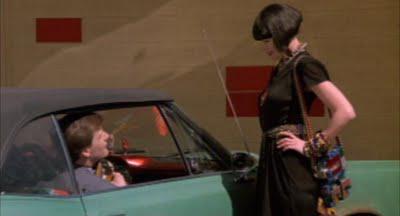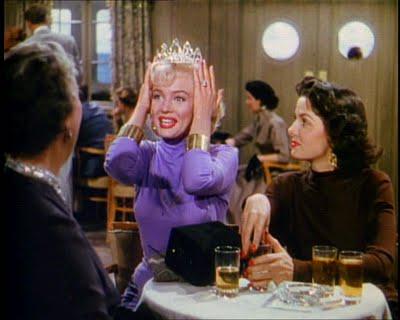
I put off watching this film for years because it struck me as Hollywood moralizing that would inevitably resort to stereotypes and a skewed sense of self-righteousness. (I know it's wrong to pre-judge a film, but come on, didn't I just describe 99.9% of Hollywood racial dramas?) But In the Heat of the Night was everything I thought it wouldn't be: even-handed rather than polemical, nuanced and not bludgeoned, artistic rather than cheaply ripped from the headlines. Virgil Tibbs, the displaced Philadelphia homicide detective, wants to get out of the Mississippi town in which he finds himself involved in an investigation as much as the local cops want him gone. The chief, Gillespie (Rod Steiger), doesn't hide his prejudices, but he also notes Tibbs' own to goad the officer he knows is talented into staying. He knows that a man like Tibbs would like nothing more than to solve the mystery and prove himself better than all these country hicks, and Poitier's steely gaze cannot hide his agreement with the assessment.
This revelation of Tibbs' own racial hangups is not an attempt to soften the whites but to deepen and humanize the racial commentary. Admittedly, Jewison's action scenes somewhat undercut the wisome and depth of the dialogue and acting with such on-the-nose visual cues as a Confederate flag emblem on the front fender of a car pursuing Tibbs to some obvious angling of shots of lynch mob members. Nevertheless, this is a powerful document of racial tension that has aged remarkably well, buoyed by two dynamic performances by Poitier and Steiger and scripted with intelligence. I'd like to mull this over a few more times before I'd write a full-length review, but in the meantime read Adam Zanzie's excellent piece on the film. Grade: A-
Something Wild (Jonathan Demme, 1986)

Jonathan Demme's stylish descent into yuppie hell plays like a more class-conscious take on Martin Scorsese's After Hours. Where Griffin Dunne eventually wound up right back where he started, forgetting his mad fever dream, Jeff Daniels' Charlie does not get off so lightly. His corporate VP gets swept away by a dynamo who goes by the name of Lulu (Melanie Griffin) and endures such a mad and, eventually horrific, plunge off the deep end that he must reevaluate everything he believes in. The three main characters (including a striking Ray Liotta as Lulu's insane ex-husband) are all white, but they move trough a background of multiracial and multiclass people, and Charlie's interactions with them change him. On the flip-side, the more they stick together, the more Lulu begins to domesticate, becoming the sort of bourgeois trophy wife that the normal Charlie would love to be with, though he's already become used to the wild minx version.
Demme turns the film into an exercise in duality: The film's tone switches from comedy to horror. The cinematography transitions from pastel-colored romp to cold, metallic tones so quickly the effect is at once barely noticeable and deeply unsettling. "What are you going to do now that you've seen how the other half lives?" Lulu asks, furthering the dualism by clarifying "The other half of you." The other film that makes for an easy point of comparison with the film is David Lynch's Blue Velvet, a connection made in their mutual view of small-town America as no bastion of morality in the face of rotting cities. Yet unlike Lynch's despairing suburban hell and Scorsese's expressionist frenzy, Something Wild has a real sliver of hope running through it, the idea of recognizing one's duality and finding spiritual middle class in the sharply divided racial and class system of the '80s. That's such a lofty idea I nearly forget you have to fight your way past a crazed Ray Liotta to get to it. Grade: A
Gentlemen Prefer Blondes (Howard Hawks, 1953)

Howard Hawks' brassy, vibrant Technicolor musical at first glance seems a depiction of vacant gold-digging, but the more one pays attention, the more one can only see the film as a vicious attack on the commercialized notion of romance, a deconstruction brought about by its two female leads. Russell and Monroe are so dynamic and forward they seem to grab a hold of the camera itself and manipulate our view of them. They make an unstoppable duo, Russell's Dorothy consumes every hunk in sight, while Monroe (cannily satirizing her own public image) uses airy, wide-eyed bimbosity to set traps for rich schlubs looking for a trophy of her caliber. I don't know if a film has ever torn down the male gaze so thoroughly, not only hijacking it to show how women have sexual desires (the "fairer sex" has always been more sexually experienced than the men in Hawks' films, but here they are almost unfathomably to the males) but in the pair's manipulation of that gaze to position men right where they want them. Even if the men are sitting in a theater.
Hawks' use of musical interludes in his films (think Rio Bravo and To Have and Have Not) has always been rich in character, and the grand sequences here are as clever and telling as they are dynamic and artistic. From the opening moment, as Monroe and Russell appear in ruby-red sequins to instantly monopolize the attention, Hawks positions the musical numbers to demonstrate their utter power over men and the uninhibited expression of their own desires. Perversity gets stacked on top of perversity here, but maybe I only use that word because it's so unorthodox to be shown the female desire instead of the male gaze. This is damn near a perfect picture, as funny as it is transgressive, and one of my three favorite Hawks pictures, along with Rio Bravo and Only Angels Have Wings. Grade: A+

